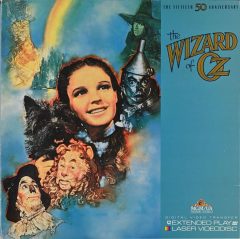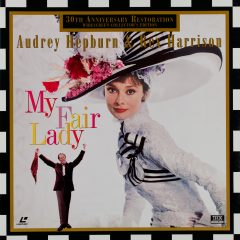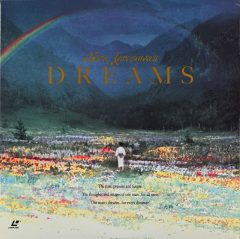Laserdiscs – An obscure yet unique video format
by Matt Piaskoki
After taking part in the creation of a detailed listing for a donation of Laserdiscs at the AVRC, I have come to admire this obscure yet unique video format. While the Laserdisc was beaten out by its contemporaries like the VHS, its story is an interesting one, from its revolutionary beginnings to its downfall and ultimate demise.
The laserdisc was the first optical disc on the market. Being the first of their kind, laserdiscs were quite large, around the size of vinyl records. It was released in the States in 1978, two years after VHS and four years before the CD. It would take almost another 20, in 1997, until its more compact successor, the DVD came out. The Laserdisc produced higher quality sound and video than the standard VHS and Betamax at the time. However, even though the format provided far superior media quality than the VHS and had an almost 20-year head start to its successor, the laserdisc failed to find its footing in the West and became a failure, quickly being forgotten about.
While optical disc technology was invented decades earlier, the laserdisc was the first commercialized use – originally branded as DiscoVision. The first film to ever be printed on these discs was Jaws in late 1978. A few years later the name “Laserdisc” became the standard in North America
The first discs’ audio tracks were only analog, but later advancements allowed for digital tracks. Audio soon became more complex as discs could have both analog and digital tracks. Some used these pair tracks to add bonuses like scores, commentary, or for making bilingual discs. While early discs were often mono or stereo, later multi-channel ones allowed for surround sound.
 Normal Laserdiscs could only play around 60 minutes of video on each side and were called “Extended Play” or CLV. Another type called “Standard Play,” or CAV allowed for more benefits like allowing varied playback or slow-motion speeds, freeze frame, and the ability to call on specific frames. The drawback was only allowing for around 30 minutes of video.
Normal Laserdiscs could only play around 60 minutes of video on each side and were called “Extended Play” or CLV. Another type called “Standard Play,” or CAV allowed for more benefits like allowing varied playback or slow-motion speeds, freeze frame, and the ability to call on specific frames. The drawback was only allowing for around 30 minutes of video.
Due to the high-quality video and sound laserdiscs provided, many films were given a laserdisc release. Film enthusiasts preferred this format over the inferior viewing experience of the VHS. While quality was much higher than VHS, so were the prices. Laserdiscs and their players were much more expensive than other formats at the time in North America. For most people the better quality wasn’t worth the extra price and stayed with VHS. In the East, in countries like Japan and Hong Kong, the Laserdisc was more successful due to cheaper prices of both the disc and players, leading to a higher adoption rate.
Prices were not the only reason Laserdisc failed. The size, weight, and fragility of laserdiscs turned many away and favored the more reliable and accessible VHS. Each Laserdisc could only handle either around 60 minutes or 30 minutes of video per side depending on the type. For films, this meant flipping or swapping discs during the movie. Larger movies or ones that heavily used CAV came with many discs, making for a more cumbersome movie viewing experience.
Today Laserdiscs are often forgotten about as they were always overshadowed by their more popular competitors. Once the DVD came to market, it effectively killed off the last of the laserdisc. Today only a small, dedicated fanbase of cinephiles still use and collect this obsolete video format. As functioning high-quality players become harder to find and certain discs have now succumbed to disc rot, it has become much harder to play Laserdiscs.

The AVRC’s collection of Laserdiscs was acquired largely through donation and contains many films, with both Western and Eastern releases. They also have many ballets, operas, and classical music discs. They acquired some special release films, such as My Fair Lady, Amadeus, and The Sound of Music which include bonuses such as books, soundtrack CDs, and screenplays. Another notable special release is a set of the original Star Wars trilogy, with the rare original theatrical cut. Due to the high-quality Laserdisc provided and being popular with cinephiles and film collectors, many special editions were made for the Laserdisc format. While it may not have shared the success and popularity of formats like VHS and DVD, Laserdisc still played a key role in the history of media storage. I enjoyed learning about the interesting story of Laserdiscs and hope others take intrigue in it too.
